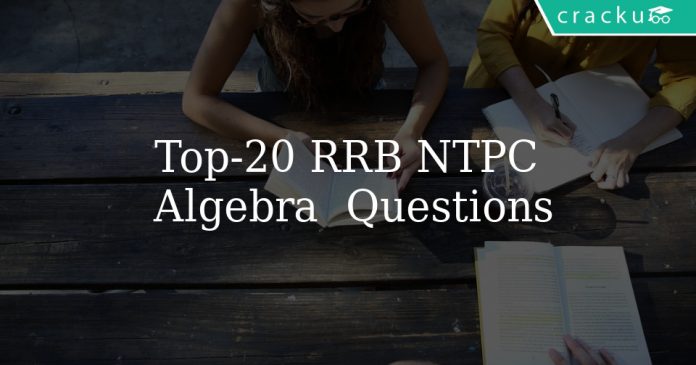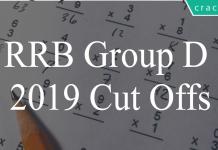RRB NTPC Algebra Questions:
Download Top-20 Algebra questions for RRB NTPC exam. Most important Algebra questions based on asked questions in previous exam papers for RRB NTPC.
Download Top-20 RRB NTPC Algebra Questions
Get 20 RRB NTPC Mocks – Just Rs. 149
Take a free RRB NTPC mock test
Download RRB NTPC Previous Papers PDF
Question 1: The smallest positive integer n with 24 divisors considering 1 and n as divisors is
a) 420
b) 240
c) 360
d) 480
Question 2: In an election a candidate gets 40% of votes polled and is defeated by the winning candidate by 298 votes. Find the total number of votes polled.
a) 1360
b) 1490
c) 1520
d) 1602
Question 3: Two numbers are less than the third number by 30% and 37% respectively. By what percent is the second number less than the first number?
a) 15%
b) 10%
c) 25%
d) 20%
Question 4: If 15 boys earn Rs.900 in 5 days, how much will 20 boys earn in 7 days ?
a) Rs. 1980
b) Rs. 1820
c) Rs. 1780
d) Rs. 1680
Question 5: Srinivas is four times as old as his daughter. Five years ago, Srinivas was nine times as old as his daughter was at that time. His daughter’s present age is:
a) 10 years
b) 8 years
c) 6 years
d) 5 years
Question 6: If $a$ is positive and $a^2 + \frac{1}{a^2} = 7,$ then $a^3 + \frac{1}{a^3} = ?$
a) 21
b) $3 \sqrt7$
c) 18
d) $7 \sqrt7$
Question 7: Which of the following statement is sufficient to answer the question? Find the values of x, y, z from the given statements.
Statements:
I. x + y = 12 ; x + z = 4
II: x – y = 6
a) Only II is sufficient while I is not
b) Neither I nor II is sufficient
c) Both I and II are sufficient
d) Only I is sufficient while II is not
Question 8: $ If a + \frac{1}{a} = 1, $ find the value of $ a^{3} + \frac{1}{a^{3}} $
a) 2
b) -2
c) 0
d) 1.5
Question 9: If $12x^2- ax + 7 = ax^2 + 9x + 3$ has only one (repeated) solution, then the positive integral solution of a is:
a) 2
b) 4
c) 3
d) 5
Question 10: If $\frac{x}{x^{2}-1}$=$\frac{A}{x-1}+\frac{B}{x+1}$ then find the values of A and B
a) 2,2
b) 2,-2
c) $\frac{1}{2}$, $\frac{-1}{2}$
d) $\frac{1}{2}$, $\frac{1}{2}$
Join Exam Preparation Telegram Group
Question 11: Find the value of $\frac{1}{1\times2}+\frac{1}{2\times3}+\frac{1}{3\times4}+\frac{1}{4\times5}+\frac{1}{5\times6}+….+\frac{1}{9\times10}$
a) $\frac{1}{10}$
b) $\frac{9}{10}$
c) $\frac{5}{11}$
d) $\frac{2}{5}$
Question 12: simplify $\sqrt{0.01+\sqrt{0.0225}}$
a) 16
b) 0.4
c) 4
d) 0.04
Question 13: Simplify $ \frac{121}{3\frac{2}{3}}+\frac{92}{7\frac{1}{3}}$ ?
a) $43\frac{11}{19}$
b) $41\frac{12}{13}$
c) $40\frac{13}{11} $
d) $45\frac{6}{11} $
Question 14: If $x^{3}$ = n and the units digit of ‘n’ is a prime number, what are the possible choices for ‘x’ among
the numbers from 1 to 9.
a) 3, 5, 7, 8
b) 3, 5 ,7
c) 2, 3, 4, 5
d) 1, 5, 3
Question 15: simplify$\sqrt{10+\sqrt{25}+\sqrt{108}+\sqrt{154}+\sqrt{225}}$?
a) 3
b) 8
c) 4
d) 6
Get 20 RRB NTPC Mocks – Just Rs. 149
Question 16: If $\frac{a}{b}+\frac{b}{a}=1 $then find $a^{3}+b^{3}$
a) 2
b) -1
c) 0
d) 1
Question 17: Evaluate $1+\frac{1}{2}+\frac{1}{4}+\frac{1}{8}+\frac{1}{16}+…… $?
a) $\frac{1}{50}$
b) 3
c) $\frac{1}{22}$
d) 2
Question 18: Simplify: $\frac{1\frac{1}{4} \div 1\frac{1}{2}}{\frac{1}{15} + 1- \frac{9}{10}}$
a) 2
b) 5
c) 3
d) 4
Question 19: If A + B = C, D – C = A and E – B = C,then what does D + F stand for?
a) C
b) F
c) J
d) Q
Question 20: Evaluate: $\left[\frac{\sqrt{3} + 1}{\sqrt{3} – 1}\right]^2 + \left[\frac{\sqrt{3} – 1}{\sqrt{3} + 1}\right]^2$
a) 16
b) 12
c) 14
d) 24
Download RRB NTPC Previous Papers
Answers & Solutions:
1) Answer (C)
For any given number, that can be represented as $ A^{x} \times B ^ {y} $, etc
The number of factors is denoted by (x+1) x ( y+1), etc
360 = $ 2 ^ {3} \times 3 ^ {2} \times 5^ {1}$
So the number of factors = (3 +1) x (2+ 1) (1+ 1) = 4x3x2 = 24
For 240, it is $ 2 ^ {4} \times 3 ^ {1} \times 5^ {1}$
Number of factors = 5 x 2 x 2 = 20 only
2) Answer (B)
There is an assumption in the question that there are only two candidates participating in the election. One candidate got 40% votes and the other candidate got 60% votes. The difference is 20% votes which are 298. If 298 votes are 20%, 100% is how much.
= 298/20% = 1490
3) Answer (B)
Let the third number be x. So, the first number is .7x
The second number is .63x
So, the second number is less than the first number by .7 ie 10% of the first number.
4) Answer (D)
Amount of money earned by a boy in a day = $\frac{900}{15*5}$ = Rs. 12
Hence, amount of money earned by 20 boys in 7 days = 20*7*12 = Rs. 1680
5) Answer (B)
6) Answer (C)
$a^2 + \frac{1}{a^2} = 7$
Addition 2 in both sides of equation.
$a^2 + \frac{1}{a^2} + 2 = 7+2$
$a^2 + \frac{1}{a^2} + 2 = 9$ Eq.(1)
Eq.(1) is making the formula of $(a+\frac{1}{a})^{2}$.
After removing the square got $(a+\frac{1}{a}) = \pm 3$
In question, it is mentioned that value of a is positive.
So $(a+\frac{1}{a}) = 3$ Eq.(2)
In Eq.(2) apply formula $(a+\frac{1}{a})^{3}$.
So $(a+\frac{1}{a})^{3} = a^{3} + (\frac{1}{a})^{3} + 3 \times a \times (\frac{1}{a}) [a + \frac{1}{a}]$
$(a+\frac{1}{a})^{3} = a^{3} + (\frac{1}{a})^{3} + 3[a + \frac{1}{a}]$ Eq.(3)
Put Eq.(2) in Eq.(3).
$(3)^{3} = a^{3} + (\frac{1}{a})^{3} + 3\times3$
$27 = a^{3} + (\frac{1}{a})^{3} + 9$
$27-9 = a^{3} + (\frac{1}{a})^{3}$
$18 = a^{3} + (\frac{1}{a})^{3}$
$a^{3} + (\frac{1}{a})^{3} = 18$
7) Answer (D)
8) Answer (B)
Given, $a + \frac{1}{a} = 1$
Cubing on both sides we get,
$a^{3} + \frac{1}{a^{3}} + 3(a + \frac{1}{a}) = 1$
$ a^{3} + \frac{1}{a^{3}} = -2$ ( as we know $a + \frac{1}{a} = 1$)
Hence, option B is the correct answer.
9) Answer (C)
Given, $12x^2- ax + 7 = ax^2 + 9x + 3$
$(a-12)x^2 + (a+9)x-4 = 0$
If $ax^2+bx+c=0$ has equal roots, then $b^2 = 4ac$
$(a+9)^2 = 4(a-12)(-4)$
$a^2+81+18a = 192-16a$
$a^2+34a-111 = 0$
On solving above equation, we get a = 3 and a = -37.
Here, The positive integral solution will be 3.
10) Answer (D)
11) Answer (B)
12) Answer (B)
13) Answer (D)
14) Answer (A)
15) Answer (C)
Get 20 RRB NTPC Mocks – Just Rs. 149
16) Answer (C)
17) Answer (D)
$1+\frac{1}{2}+\frac{1}{4}+\frac{1}{8}+\frac{1}{16}+…… $
Use GP formula as
$\frac{(1-r^n)}{(1-r)}$
here $n = \infty$
therefore, $\left(\frac{1 – \left(\frac{1}{2}\right)^{\infty}}{1 – \left(\frac{1}{2}\right)}\right)$
$\frac{1}{\left(\frac{1}{2}\right)} = 2$
18) Answer (B)
19) Answer (C)
20) Answer (C)
Using the identities
$ (a + b)^2 = a^2 + 2ab + b^2 $
$ (a – b)^2 = a^2 – 2ab + b^2 $
$ (a + b)(a – b) = a^2 – b^2 $
Rationalizing the denominator,
$\left[\frac{\sqrt{3} + 1}{\sqrt{3} – 1}\right] = \frac{\sqrt{3} + 1}{\sqrt{3} -1} \times \frac{\sqrt{3} + 1}{\sqrt{3} +1} $
Solving the equation using identities we get
$ \frac{\sqrt{3} + 1}{\sqrt{3} -1} \times \frac{\sqrt{3} + 1}{\sqrt{3} +1} = \frac{4 + 2\sqrt3}{2} $
= $ 2 + \sqrt 3 $
$\left[\frac{\sqrt{3} + 1}{\sqrt{3} – 1}\right]^2 = (2 + \sqrt 3)^2$
= $ 7 + 4\sqrt3 $
Rationalizing the denominator,
$\left[\frac{\sqrt{3} – 1}{\sqrt{3} + 1}\right] = \frac{\sqrt{3} – 1}{\sqrt{3} +1} \times \frac{\sqrt{3} -1}{\sqrt{3} -1} $
Solving the equation using identities we get
$ \frac{\sqrt{3} -1}{\sqrt{3} +1} \times \frac{\sqrt{3} – 1}{\sqrt{3} -1} = \frac{4 – 2\sqrt3}{2} $
= $ 2 – \sqrt 3 $
$\left[\frac{\sqrt{3} -1}{\sqrt{3} + 1}\right]^2 = (2 – \sqrt 3)^2$
= $ 7 – 4\sqrt3 $
Thus,
$\left[\frac{\sqrt{3} + 1}{\sqrt{3} – 1}\right]^2 + \left[\frac{\sqrt{3} – 1}{\sqrt{3} + 1}\right]^2 = 7 + 4\sqrt 3 + 7 – 4\sqrt 3 $
= 14
Join Exam Preparation Telegram Group





